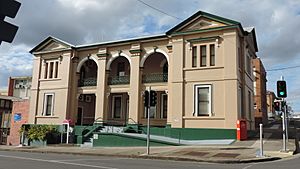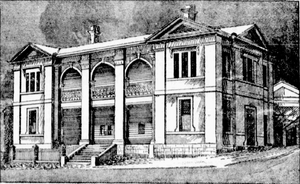Old Gympie Post Office facts for kids
Quick facts for kids Old Gympie Post Office |
|
|---|---|

Old Gympie Post Office, 2015
|
|
| Location | 22 Channon Street, Gympie, Gympie Region, Queensland, Australia |
| Design period | 1870s - 1890s (late 19th century) |
| Built | 1878 - 1880 |
| Architect | Francis Drummond Greville Stanley |
| Architectural style(s) | Classicism |
| Official name: My Country; Old Post Office, Gympie Post Office | |
| Type | state heritage (built) |
| Designated | 21 October 1992 |
| Reference no. | 600534 |
| Significant period | 1878-1880, 1898-c. 1901, 1950s (fabric) 1870s-1970s (historical, social) |
| Significant components | residential accommodation - post master's house/quarters, post & telegraph office |
| Builders | Andrew Collins |
| Lua error in Module:Location_map at line 420: attempt to index field 'wikibase' (a nil value). | |
The Old Gympie Post Office is a special building in Gympie, Queensland, Australia. It used to be a post office and is now protected as a heritage site. It was designed by a famous architect named Francis Drummond Greville Stanley and built between 1878 and 1880. This building is also known as My Country and was added to the Queensland Heritage Register in 1992 because of its historical importance.
Contents
History of the Gympie Post Office
The Old Gympie Post Office is a large, two-storey building made of stone. It was the third post office built in Gympie. The architect, F. D. G. Stanley, was the Queensland Colonial Architect. This means he was the main architect for the government in Queensland at that time. He designed many public buildings. This post office is one of eleven similar ones built across Queensland between 1878 and 1898.
Queensland's Early Mail Services
Queensland got its first postmaster in 1842. The first mail delivery service started in 1845. By 1859, there were fifteen post offices in Queensland. In the 1860s, telegraph stations were set up. These linked most towns to Brisbane, allowing messages to be sent quickly. More telegraph offices were built than post offices. In 1879, the post and telegraph services joined together. They were run by the Queensland Government until 1901. After Federation, they became part of the Federal Government.
The Gold Rush in Gympie
The town of Gympie began after gold was found there in 1867 by James Nash. At that time, Queensland was in financial trouble. The government offered a reward for anyone who found gold. James Nash received £3,000, and many people rushed to Gympie. By 1869, thousands of people lived there. The town grew so fast that it was laid out in an unusual way. Instead of straight streets, it followed the hills and mining areas.
The Need for a New Post Office
In 1867, people started complaining about not having good postal services in Gympie. So, a postal service was set up, and E. H. Booth became Gympie's first postmaster. He ran the post office from a shop. The service grew quickly.
By 1868, an official postmaster was appointed. This was the fastest a postal service had grown in the colony's history. A second post office building was opened. However, the gold rush continued to bring more people to Gympie. The second post office quickly became too small.
A piece of land was chosen for a new post office. It was on Commissioner's Hill, at the corner of Duke and Channon Streets. But this spot was far from the town centre. Residents protested and sent a petition with 500 signatures. The government ignored them, and building started on the chosen site.
Building the Third Post Office
Tenders (offers to build) for the new post office were asked for in May 1878. The offers were too expensive. So, the government negotiated with Andrew Collins, who had the lowest offer. They decided to make the building a bit shorter to save money. The contract was signed in August 1878. However, the building took longer to finish than planned. This was due to bad weather and not enough skilled workers.
The building was finally finished in 1880. It had space for the post office, the telegraph office, and the land commissioner. It also had living quarters for the postmaster and his family. Downstairs were the post and telegraph offices, each with its own entrance. The land commissioner's office was at the Channon Street end. The rest of the building, mostly upstairs, was the postmaster's home. There was also a separate kitchen and bedroom at the back.
Changes Over Time
In 1898, the land commissioner moved out. This allowed for changes to the post office. They removed a staircase and added a new room at the back. They also changed some windows and doors. More changes happened in 1901 when a telephone exchange opened. In 1954, the postmaster's home was turned into a new telephone exchange.
In 1964, a new Automatic Telephone Exchange building was opened next to the old Post Office. This made Gympie's telephone services very modern. Both the post office and telephone exchange continued to grow. Eventually, the building became too small again. On November 14, 1975, a new post office opened in Mary Street, and the old one closed.
The building was bought by Telecom (the phone company at the time). In 1994, it was given to the Gympie City Council. In 2019, a local company bought the building. They plan to fix it up and use it as their office.
Design and Features
The Gympie Post Office is a large, two-storey building made of stone. It stands out at the corner of Channon and Duke Streets. It is part of a group of important government buildings, including the Lands Office, Police Station, and Court House.
Outside Appearance
The front of the building, facing Duke Street, is very balanced. It has a central section with arched colonnades (rows of columns) on both floors. On either side are solid sections. The central part has three large openings that go up two floors. These openings have arches at the top and a verandah (balcony) in the middle. Between the arches are pilasters (flat, decorative columns) with fancy tops. Other decorations include keystones (wedge-shaped stones at the top of arches), small brackets under the verandah, and cast iron railings. The sections on the ends have one window downstairs and three windows upstairs. Each end section has a triangular pediment (a triangular shape often found on top of buildings). Decorative lines called string courses run along the building at each floor level.
The side of the building facing Duke Street continues this design. It has a slightly sticking-out central part with a triangular pediment. There is also another entrance at the northern end of this side.
Inside the Building
Inside, many of the original walls that divided the post office spaces have been removed. This makes the ground floor an open area. Three octagonal (eight-sided) timber posts support the floor above. There are staircases with decorative timber railings at the back corners of the building. One of these stairs is a copy of the other original one. Most of the original wooden features, like doorframes, are still there. Only the skirtings (boards along the bottom of walls) have been replaced.
The first floor has a corridor that runs between the staircases at the back. The front part of this floor has offices, divided by new walls. All the offices open onto the verandah. A new bathroom has been added at the western end of the building.
Why is it a Heritage Site?
The Old Gympie Post Office was added to the Queensland Heritage Register in 1992 for several reasons:
- It shows how Queensland's history has changed.
Finished in 1880, this was Gympie's third post office. It shows how much the town grew, and how government services expanded across Queensland.
- It shows what a building of its type should look like.
This post office is a great example of a large, two-storey stone building with classic design elements. It's typical of government buildings from that time.
- It is beautiful and important to the area.
The building is important because it's a landmark and adds to the beauty of the street. It's part of a group of important government buildings. Its design, including the cast iron railings and wooden features inside, is also very appealing.
- It is linked to an important person in Queensland's history.
The Gympie Post Office is connected to the famous Queensland architect, F. D. G. Stanley. It's one of the last buildings he designed while he was the Colonial Architect.


